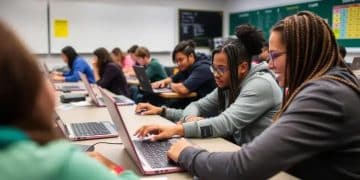Hybrid learning success trends: what you need to know

Hybrid learning success trends reveal that combining online and in-person education enhances student engagement, personalization, and flexibility, preparing them for future challenges.
Hybrid learning success trends are reshaping education as we know it. Have you ever wondered how blending online and in-person classes can boost student engagement and learning outcomes? Let’s dive in!
Understanding hybrid learning models
Understanding hybrid learning models is essential for grasping how education is evolving today. Hybrid learning combines traditional face-to-face teaching with online methods, creating a flexible environment. This approach allows students to learn at their own pace, making education more accessible.
Types of Hybrid Learning Models
There are several types of hybrid learning models employed in educational settings:
- Flipped Classroom: Students learn new content online and use classroom time for discussion and practice.
- Rotation Model: Students rotate between online and in-person classes, getting the best of both worlds.
- Self-Blend: Students choose to take some courses online while attending others in person.
These models highlight the versatility of hybrid learning. Each model caters to different learning styles and needs, making it adaptable for diverse student populations. By blending online access with face-to-face interactions, educators can enhance engagement and comprehension.
Advantages of Hybrid Learning
There are numerous benefits to employing hybrid learning models. For instance, they offer flexibility, allowing students to schedule their learning around other commitments. Additionally, this approach can increase student motivation, as it often includes interactive online components. Moreover, hybrid learning can help educators personalize their teaching strategies, addressing individual student needs effectively.
Furthermore, with technology integration, educators have access to a wealth of online resources, making lessons more engaging and relevant. The combination of methods can also prepare students for a more digital world, equipping them with necessary skills.
In summary, hybrid learning models present various opportunities for enhancing educational experiences. Understanding how these models work can empower educators and students alike to navigate the changing landscape of learning more effectively.
Key benefits of hybrid learning

Hybrid learning offers several key benefits that enhance the educational experience for students and teachers alike. By combining online and in-person learning, this approach caters to diverse learning styles while promoting greater engagement.
Flexibility and Convenience
One of the primary advantages of hybrid learning is its flexibility. Students can access course materials online and learn at their own pace. This model accommodates busy schedules and enables individuals to balance priorities such as work or family responsibilities.
- Adaptable Learning: Students can revisit lessons and materials whenever they need.
- Time Management: Learners can plan study times that suit their routines.
- Accessibility: Materials are often available to those who may struggle to attend in person.
Furthermore, hybrid learning fosters a personalized approach. Educators can tailor lessons to meet individual needs. Teachers can identify areas where students excel and where they require additional support. This direct feedback loop helps to enhance the learning process significantly.
Enhanced Engagement and Interaction
Another benefit is the potential for increased engagement. Online platforms often incorporate interactive elements like discussions, quizzes, and multimedia resources. These tools can capture a student’s interest and motivate them to participate actively.
Additionally, the hybrid model encourages strong communication between students and teachers. Through online forums and virtual classrooms, students gain more opportunities to ask questions and share ideas. The blend of learning environments thus promotes collaboration.
The shift toward hybrid learning also prepares students for future workforce demands. As many industries adopt remote work and digital communication, hybrid education teaches essential skills like self-discipline and technology proficiency. Ultimately, students are not only learning content but also developing skills needed for success in their careers.
Strategies for successful implementation
Implementing hybrid learning successfully requires thoughtful planning and execution. To thrive in this educational model, institutions can consider several effective strategies. Communication and collaboration among educators, students, and parents are vital for creating a supportive learning environment.
Train Educators Effectively
One critical strategy is to ensure that educators are well-trained in both in-person and online teaching methods. This training should cover tool usage, pedagogical tactics, and methods for engaging students in a hybrid setting. Teachers should feel confident using technology and facilitating discussions in both realms.
- Workshops: Schedule regular workshops for teachers to learn new tools and strategies.
- Peer Mentoring: Pair experienced educators with those new to hybrid teaching for guidance.
- Feedback Loops: Encourage educators to share feedback and improve practices collectively.
Another important aspect is to provide students with clear guidelines and expectations for participation in both online and in-person formats. This clarity helps students understand their responsibilities and stay engaged throughout their learning journey.
Foster a Strong Community
Building a supportive community is essential for a successful hybrid learning experience. Schools should promote collaboration between students, teachers, and parents. Engaging all parties creates a solid foundation for growth and learning.
Establishing channels for open communication enhances relationships and provides students with the support they need. Communities can hold regular forums or meetings to discuss challenges and celebrate successes, creating a sense of belonging.
Moreover, utilizing technology tools effectively can enhance the learning experience. Tools like collaborative platforms and online resources enable seamless collaboration among students and teachers. By leveraging these technologies, instructors can ensure that students remain connected and engaged no matter where they are learning.
Future trends in hybrid education

Future trends in hybrid education are shaping the way we think about learning. As technology continues to evolve, educators must adapt to new tools and methods that enhance the hybrid classroom experience.
Increased Use of Technology
One key trend is the increasing reliance on technology in the classroom. With advancements in online learning platforms and tools, educators can create more interactive and engaging lessons. Virtual reality (VR) and augmented reality (AR) are becoming prominent, providing immersive experiences that enhance learning.
- Interactive Learning: Students can participate in virtual labs or field trips, making lessons more memorable.
- Personalized Learning: Technology enables customized learning paths tailored to student needs and interests.
- Adaptive Assessments: Online assessments can adjust their difficulty based on student performance.
Moreover, as students become more familiar with technology, they expect these tools to be integrated into their learning. This trend encourages schools to invest in the latest educational technology to maintain student engagement.
Focus on Social and Emotional Learning
Another significant trend is the growing emphasis on social and emotional learning (SEL) within the hybrid model. Educators recognize the importance of addressing students’ emotional well-being, especially in a blended environment. By promoting SEL, schools can create a supportive atmosphere where students feel safe and valued.
Incorporating SEL into hybrid education can enhance students’ ability to manage their emotions and establish positive relationships. Students learn to communicate effectively and collaborate with peers in both in-person and online settings.
The future of hybrid education will likely be characterized by a more holistic approach that considers not only academic success but also emotional and social growth. This balance is crucial for preparing students for the challenges they will face in the world beyond the classroom.
FAQ – Frequently Asked Questions about Hybrid Learning
What are the main benefits of hybrid learning?
Hybrid learning offers flexibility, increased engagement, and personalized education. It allows students to learn at their own pace while benefiting from both online and in-person interactions.
How does technology enhance hybrid education?
Technology provides tools for interactive learning, such as virtual reality and online resources, making lessons more engaging and accessible for students.
What is the role of social and emotional learning in hybrid education?
Social and emotional learning helps support students’ emotional well-being, improving their ability to communicate and collaborate in both online and face-to-face environments.
How can teachers effectively teach in a hybrid model?
Teachers can succeed by receiving proper training, utilizing technology, maintaining open communication with students, and fostering a supportive learning community.






